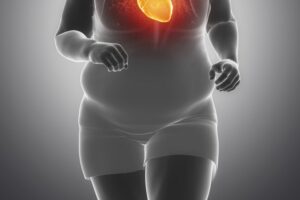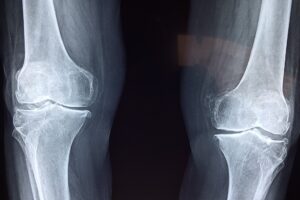Let’s be real, Irritable Bowel Syndrome is no joke. Those with it are familiar with the symptoms: abdominal pain, intermittent diarrhea or constipation, gas, nausea, and loss of desire to eat.1 Some estimates reveal that the global prevalence is 11.2%, with women and those under 50 suffering the most.1
Of all the causes, what is known is that 50-84% of those suffering with IBS report food triggers. This makes nutritional interventions the core to IBS treatment. Older interventions are known to many such as lactose restriction (or lactase supplementation) for those with lactose intolerance (a classic form of IBS), or fiber restriction in general. Fortunately we have moved beyond these simple solutions and for good reason. It is well known that fiber is important for the intestinal microbiome due to the role that the bacteria in our microbiome play in producing the short chain fatty acid butyrate.2,3 The challenge is restricting triggers while not sacrificing too much fiber because this could make the situation worse in the long term.
The Low FODMAP diet
Let’s start off by defining FOPDMAPs. To some sources the term stands for fermentable, oligosaccharides, disaccharides, and polys. The polys in FODMAP refer to polyols which are sugar alcohols used as zero calorie sweeteners.
Common FODMAP foods/additives
| FODMAP Catagory | Examples |
| Oligosaccharides(fructans, oligofructose, inulin, fructo-oligosacharides), galacto-oligosacharides (raffinose, stachyose) | Wheat, rye, onion, garlic, artichoke, dairy products, pulses, legumes, some nuts |
| Disaccharides (lactose) | Milk and milk products |
| Monosaccharides (fructose) | Mango, fig, honey, fructose corn syrup, sweeteners in some dairy products, jam |
| Polys (sorbitol, mannitol, lacitol, xylitol, erythritol, maltitol) | Mostly additives found in packaged foods and chewing gum but can also be found in cauliflower, mushrooms, apples, and stoned fruits (apricots, olives, loquat, peaches, plums, cherries, mangoes, and amlas) |
The Low FODMAP elimination diet
Typically the elimination period for a Low FODMAP diet is up to 4-6 weeks. After the elimination period there is a 6-10 week reintroduction phase where foods are slowly added in back into the diet in a challenge and evaluate fashion. Some practitioners add an entire FODMAP category while others focus on specific foods. It is really up to the best judgement of the clinician and client because some people have been shown to have an intolerance with an entire FODMAP category while others only have issues with specific foods. When challenging, foods are added in increasing amounts over a 3-day period. During the 3 days, close monitoring of food intake, and symptoms is vital. When moving to another food to challenge, one day of no FODMAPs allows the client to not confuse the symptoms of the previous challenge from being mistaken for the current challenge. After the challenge phase is completed, the personalization phase begins. During this phase the foods that were successfully challenged (did not produce symptoms) can be slowly reintroduced at increasing quantities over time. This is a key phase as it is extremely important for everyone to maximize dietary variety in foods eaten to ensure adequate nutrient consumption, including fiber for the microbiome.
Issues and pitfalls
One of the major issues with the Low FODMAP diet is that when people do it without the guidance of a nutritionist they may mistakenly cut unnecessary foods. This is common with people who perform a FODMAP elimination with another type of elimination diet. This can lead to dangerous nutrient deficiencies and can be confusing to both client and nutritionist alike.
A second issue with Low FODMAP diets is that some people are afraid to reintroduce the food back after finding symptom relief. It is well known that anxiety and the nervous system can cause gastrointestinal symptoms of their own. Not only can this make it difficult during reintroduction, but it also can make it difficult to tell if a gastrointestinal symptom is stress induced or food induced thus impacting the reliability of determining which foods are the culprits during the reintroduction phase. Given the prevalence of FODMAPs in processed foods, it can be stressful for many to go through a Low FODMAP diet. This makes it extremely important for a client to practice a variety of stress reduction practices while on a Low FODMAP diet.
Important WARNING!!: The Low FODMAP diet is a medical diagnostic tool and it not meant to be a long term eating plan for any individual. If FODMAP foods are eliminated for an extended period of time or without the guidance of a nutritionist, it can lead to serious nutritional deficiencies which could exacerbate the symptoms or lead to other health issues entirely. The point of the diet is to discover foods that are causing gastrointestinal symptoms and eliminate them for symptom relief. After a period of time many individuals find that they are able to reintroduce some, if not all foods, while others have less freedom to do so.
Special note: At least one study has shown that probiotic supplementation during a Low FODMAP elimination can prevent some of the die off that occurs to the microbiome while eating Low FODMAP.4 Preventing this bacterial die off is crucial to long term health. Ask your nutritionist or physician if probiotic supplementation will work for you. They may decide to wait till the personalization phase to introduce a probiotic supplement or probiotic containing foods.
References:
1. Whelan, K., Martin, L. D., Staudacher, H. M., & Lomer, M. C. E. (2018). The low FODMAP diet in the management of irritable bowel syndrome: an evidence-based review of FODMAP restriction, reintroduction and personalization in clinical practice. Journal of Human Nutrition and Dietetics, 31(2), 239–255. doi:10.1111/jhn.12530
2. Holscher H. D. (). Dietary fiber and prebiotics and the gastrointestinal microbiota. Gut microbes, 8(2), 172–184. doi:10.1080/19490976.2017.1290756
3. So, D., Whelan, K., et al. (2018). Dietary fiber intervention on gut microbiota composition in healthy adults: a systematic review and meta-analysis. The American Journal of Clinical Nutrition, 107(6), 965–983. doi:10.1093/ajcn/nqy041
4. Staudacher H.M., et al. (2017) A diet low in FODMAPs reduces symptoms in patients with irritable bowel syndrome and a probiotic restores bifidobacterium species: a randomized controlled trial. Gastroenterology 153, 936–947.







